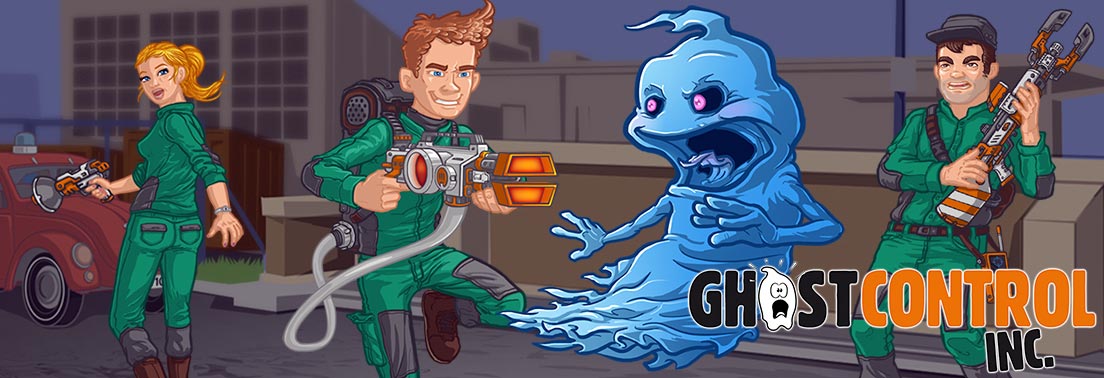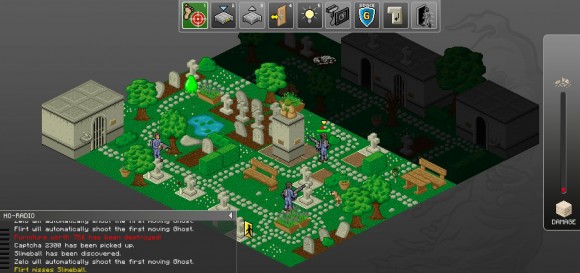It begins as another average day for Barry, a six-year veteran of Transport for London. Barry works on the London Underground monitoring signalling equipment. Someone recently poured a lot of fast-setting concrete into a signalling room on the Victoria line, which Barry doesn’t generally work on, but he’s had enough experience of incompetent and poorly-trained contractors to get riled up about the very idea of the incident.
It’s also a little bit funny. Just a little bit, mind.
Barry’s day begins at 4am, well in advance of the usual commuter rush. And by 5.30am he’s beginning to think that it isn’t going to be just another average day. Strange lights in the tunnels. Strange noises coming from… well, nowhere in particular, as far as Barry can tell.
By 5.45am Barry is fairly sure that the concrete in the signalling room had nothing to do with contractors at all. Something’s really got Barry spooked. So he reaches for the phone…
As established in last week’s post about the game’s cover, GhostControl Inc. is the first released game from Bumblebee Games, a small studio based in Markausen, part of the city of Wiehl in West Germany.
The game draws obvious inspiration from the 1990s, arguably a golden age of PC games when independent development companies and mid-list publishers still roamed the Earth. It’s evident in GhostControl’s visuals, with both of its layers of gameplay featuring a sprite-based isometric perspective and hand-drawn pixel art. It’s evident in the game’s mechanical lineage, too, with its hybrid of real-time strategic overworld and turn-based tactical combat most obviously recalling UFO: Enemy Unknown and its sequels alongside other titles such as Imperium Galactica. Its further evident in its desire to be a easy-to-play, difficult-to-master comedic business strategy game in the vein of Bullfrog titles like Theme Hospital.
And, of course, there’s more than a small tip of the hat to 1984’s GhostBusters, which has spawned many videogames from its franchise womb but only one strategic title: the very first, for the NES, Master System and Atari 2600, which was also a comedic title, albeit mostly for its appalling localisation.
So what does GhostControl offer us via its 80s spark, 90s inspiration and modern origin?
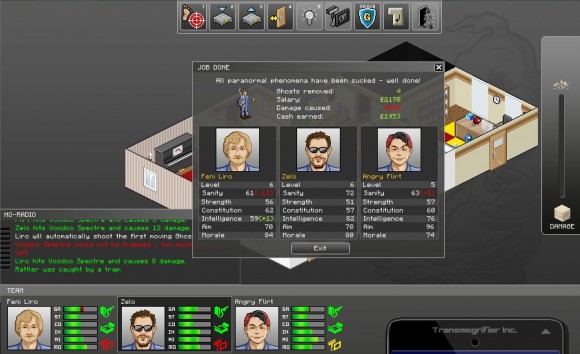
Play starts off simply enough with a basic overarching objective, some simple in-game instructions, and a UI that if not intuitive by modern usability standards is at least familiar to anyone versed in the games that inspired GhostControl. You’re soon thrown into a tactical mission, wherein your starting ghost hunter tracks down a single weak poltergeist, and introduced to your anti-spook ordnance and ghost traps.
Ghosts each have a certain amount of energy which must be reduced below a certain threshold before they can be trapped, meaning it’s necessary to zap them a few times first. Weapons possess a range of attributes beyond the usual range, damage and accuracy considerations, with the most common being ‘push’ and ‘pull’. The effects are obvious: a weapon marked ‘Pull 1’ will tug a successfully hit ghost one tactical grid square toward a hunter, and ‘Push 3’ will attempt to shove a ghost three squares away from him or her. Place a trap in front of a poltergeist and zap it with a ‘Pull 1’ weapon to lower its energy and simultaneously pull it over the trap. Hey presto, zapped and trapped!
It’s a setup that promises interesting tactical gameplay: not simply about blasting every enemy in sight but also about efficient management of your units: utilising movement, trap placement and a balance of weapons to get ghosts just where you want them.
Back on the overworld, you’re confronted with a map of London (or your chosen city: at some point San Francisco and Cologne should also be available). Your team of hunters cruises around the city in whatever vehicle befits your income, from a Volkswagen Beetle to a helicopter – by way of a classic ’59 Cadillac of course. Back at base you can hire and fire agents of a variety of classes, save your game, flog stored ectoplasm to raise a little more cash… and that’s about it.
There are a couple of rival companies also roving the overworld and you’ll want to be prompt in responding to calls offering jobs as your competitors aren’t shy of stealing work from you. However, you’ll also want to ensure you make regular stops at the hospital to cure your hunters of ghost-inflicted conditions and restore their sanity (the game’s equivalent of ‘health’), as well as keep your transport’s fuel tank topped up and your hunters equipped with the latest and greatest equipment from the map’s two shops.
From the get-go the overworld component of the game feels limited. Competitors stealing jobs is initially frustrating but as soon as you upgrade to a slightly better vehicle you’ll rarely miss an offer. Stopping at base appears essential only to save your game and empty traps into the ectoplasm vault; there’s nothing to do here. Even your hunters seem aware of it, forever occupying the same static pose and often blankly staring at walls. Calls come in via a mobile phone, of course, so you don’t even need any admin staff.
The game design apparently precluded any consideration of how to fill dead time between calls, which might have included cycling agents in and out of the active roster to allow a more authentic time-based recovery of ‘sanity’ than a one-stop shop at a hospital, training regimens to bring staff up to scratch in accuracy or intelligence, or even a public relations or advertising component to allow the player to affect the frequency of offered jobs and interact with the people of the city. Hell, a ghost hunter firm trying to manage public relations sounds like a rich vein for a comedic game to mine.
In practice most time spent on the overworld involves quick trips to shops to swap weapons and equipment out for something fractionally better and the occasional round trip to the hospital. As the game bears on the emptiness of this component becomes more and more obvious: upgrading your headquarters doesn’t appear to involve any significant change to anything other than your location on the map and the static graphics on the HQ screen. I suppose it’s possible that an upgraded HQ allows you access to a better vehicle; I don’t know as the objectives don’t display in that order.
Better vehicles, incidentally, are faster with higher fuel consumption. They also allow you to carry slightly more extra equipment – an almost useless feature as everything you want to use will be equipped to your hunters anyway as you can’t swap equipment mid-mission. And that’s it. Your team size is always capped at three, whether you’re driving a Beetle or a Transit Van.
The shallowness of the overarching game only gets worse once the objectives are taken into account. Initially you’re tasked with getting a better HQ, and then with owning £8k. After that it’s having a team of three hunters, getting a better car, and owning £12k. After that the objectives are all about earning more money and upgrading these meaningless items. About the only excitement thus far has been the one boss fight I’ve encountered, and that was exciting mostly because it was a different spin on the tactical component.
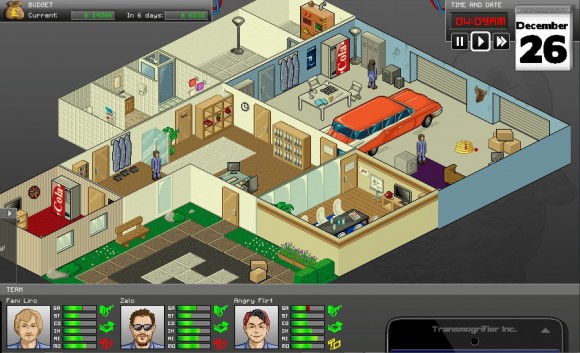
The tactical game, whilst far more satisfying overall, is not short of its own problems. Whilst initial experiments with pushing and pulling ghosts to trap them can prove satisfying, it soon becomes apparent that the easiest way to trap a ghost is to reduce its energy to near zero and then have a hunter walk up and place a trap underneath it. If you have any action points (AP) left, have someone shoot it again – this triggers a trap attempt. Wash, rinse, repeat.
This moment of realisation is difficult to avoid as the initial stage of the game lasts for far too long: pacing and progression are out of whack. Players will spend several hours hunting the same low-level ghosts for small amounts of money before they can afford to progress. When they do pass an objective they’ll find a couple of tougher ghosts in future missions… and a selection of new weapons with stats boosted to match the new threats.
Although the game does eventually increase in difficulty to the point where it is actually a challenge, it is well after the point that a certain approach has settled into the tactical game. Ghost’s attacks and abilities have ranges, so ideally you want to stay as far back as possible whilst you zap them. Once all the ghosts in an area are weakened, walk up and drop a trap. Two, if you need to. Wash, rinse, repeat.
The tougher enemies that appear later only reinforce this approach. Against less dangerous ghosts it’s conceivable that a mix of push and pull weapons could be used to corral a ghost into position over a trap by a team of hunters. In practice the small team size and two AP per hunter per turn limit hugely reduces the feasibility of this sort of positioning-based play, and once those tougher ghosts appear it would be madness to pull them toward you. Literal madness: dangerous ghosts can drive a hunter insane in a single turn, whilst they themselves possess enough energy that it can take over twelve successful hits to weaken them enough for trapping.
Incidentally, six is the maximum number of hits you can hope for in a turn. That’s if no one moves, everyone fires and every shot hits. The tactical positioning challenge boils down to ‘does every hunter have clear line of sight’. That’s it. You ensure everyone can shoot and you use ‘push’ weapons to keep ghosts at bay until they’re weakened. Then you drop traps right next to them just as you did in your first few missions.
There theoretically can be a little more to it than that: some traps have a wider capture radius, for example, or can be thrown a short distance. This doesn’t change your strategy, just the level of risk to your hunters and the flexibility you have around trap placement. Some weapons have other properties, with stun being useful against tougher enemies, but they tend to have a cooldown period which isn’t much use when you need to be firing as often as possible. You could always put another weapon in your hunter’s other hand but that means they don’t have a trap to hand, and I’ve found it inefficient to ever have a hunter without a trap to hand. This, incidentally, also renders the game’s scanning items fairly useless. You can use them to get a bit of intel at the start of a mission, but using it and then swapping it out for a trap wastes an entire turn. Better hope you don’t need that hunter shooting this turn!
Incidentally, the tactical maps are tiny. This keeps each mission brisk and quick, but it also means that there’s no range of movement available. Like a corridor FPS, you advance until you meet the enemy, you trade fire until they’re weakened, and then you finish them. You can then take a turn to pick up your traps and proceed, presuming other ghosts haven’t wandered over to take a gander.
Sometimes you have to focus on ghosts approaching from different directions, which can be tricky, but if you’ve sensibly equipped your hunters with ‘push’ weapons it’s generally not too bad. Just focus your fire as much as possible whilst fending them off. The optimum strategy – often the only sensible strategy – is tremendously formulaic.
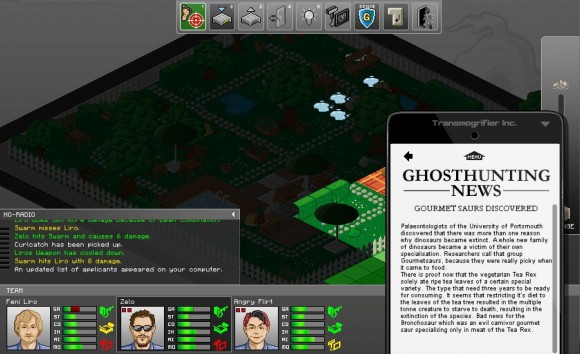
I’m saddened to be so critical of GhostControl, because it hides the fact that I’ve actually enjoyed the game to some extent. It’s lightweight fare, yes, and real challenges in it only emerge through the chance of stacked decks. But I like to play lightweight games sometimes, whether they’re sparkly pachinko machines like Peggle or shallow shooters like Blacksite. A gaming palette often desires the equivalent of junk food, and it’s no crime to indulge or produce.
Alas, as soon as you begin to look closely at the game you recognise the limitations and lack of ambition inherent in its design. There are too many deep-rooted problems here for this to be a game that presents genuine tactical possibilities, genuinely divergent challenges, or genuinely thoughtful business or strategic management.
This is not to mention the more bizarre decisions Bumblebee have made, which include the guard option (allowing hunters to fire during the ghosts’ turn) only unlocking several hours into the game, the decision to give ghosts abilities and allow hunters to be inflicted with ailments without at any point explaining them, implementing a trophy system with no means by which the player can browse it, incorporating what one presumes are in-jokes about someone called “Tassman” that are frankly indecipherable, and the fact that the game bills itself as a comedy but simply isn’t funny (example spoken audio: “I will shave your onion heads!”).
And this is to further not mention the game’s numerous bugs: misaligned stat change notifiers, shots that inflict damage on ghosts but appear to hit the opposite side of the map, active jobs disappearing between game sessions, incorrect vehicles appearing in garages, wobbly English localisation… I could honestly go on for a while. None of it is game-breaking but collectively it mars the experience.
So why do I like the game? Nostalgia has to be a part of it. The 90s were the years that made me as a gamer and the PC was my platform of choice. Plus the GhostBusters concept is a great one to build a business sim around. The charm of the game’s visuals and of its quirky if repetitive soundtrack can’t be understated, plus my constant amusement at the vehicle sound effects. (I’m convinced they’re a capella: just a man going “brrrrrm!” with a few filters whacked on top. Now that is lo-fi indie charm.)
Besides, there are only so many turn-based tactical games with a modicum of charm wherein you manage a small team on missions and must ration actions carefully. XCOM: Enemy Unknown may have fractured the myth that such a game is no longer commercially viable, but it doesn’t seem that it’s prompted a significant uptick in developers trying their hand at the genre.
Alas, these positives are not enough. Sorry, ghost hunters, but I’m afraid you’ll soon be forgotten beneath a tide of ectoplasm and a tide of better-executed games. I simply cannot recommend GhostControl, Inc, even to someone who shared my predilections and nostalgia.
